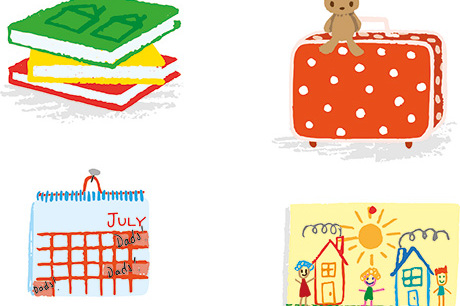
Joining two families can be an exciting new start for you all, but it is also a big transition for a child. Just remember to be open with your child and support them through any practical or emotional issues that they may encounter.
HOW TO PREPARE YOUR CHILD
It’s always important to discuss any big changes in your child’s living arrangements with them as soon as possible, so that they can accustom themselves to it and ask questions. Even toddlers need to know what is happening in basic terms.
It can be useful to share age-appropriate books with your child about different family types, having two homes or sibling rivalry.
Discuss both the positive and negative changes with your child – that your boyfriend is moving into your home, but that they will still get to see Daddy. Or, that you will be moving into a house with your partner and her children, but that they will still be able to play with their favourite toys.
Answer questions as honestly as you can and don’t promise things that you can’t deliver, such as their own bedroom.
Try not to rush any changes, so that your child can adapt to the new people in their life. You may feel very close to your partner, but has your child had the chance to get to know them and their children?
HOW YOUR CHILD MAY REACT
Many factors will influence how your child reacts to the changes, such as moving home or being separated from a family member.
The addition of a new parent figure, and perhaps step-siblings, is likely to be a big adjustment for your child. Even if they are happy with the change, they may experience feelings of disloyalty or guilt about being away from their other natural parent.
How a child adjusts to a new family unit is very personal but age can have a bearing:
Under-fives can find it easier to adjust to a new family set-up as they are less aware of ‘family politics’. But attachment is still very important and they may become ‘clingy’ with their natural parent and compete for their attention, especially if there are new siblings.
Primary-school-age children have more of a sense of personal identity and could feel their position in a family is threatened by a new partner or sibling. They may take longer to bond with new people and need plenty of reassurance.
Teenagers may be less involved in family life and prefer spending time with friends. Despite this, they could resent adopting new family routines or rules and may resist changes.
Step-siblings
Be aware that gaining a step-sibling could affect your child’s feelings of identity and security – they may go from being the youngest to a middle child, which knocks their place in the family.
Different living arrangements can make a child feel that they are not getting as much attention and cause resentment – perhaps their step-sibling gets to have sleepovers with their absent parent and yours doesn’t spend as much time with theirs.

HOW TO MAKE IT WORK
- Reassure your child that although other children are an important part of the new family, your child will continue to enjoy the same crucial place in your life.
- Ensure that you have special one-to-one time with your child, and have fun together but also discuss any anxieties.
- Don’t try to replace your step-children’s other parent or allow your new partner to do that with your ex-partner. Reassure the children that you’re simply another caring adult in their lives.
- Do not make negative comments about ex-partners in front of the children.
- Agree with your new partner how you intend to parent together, especially around discipline.
- Splitting time between parents can seem disruptive but research shows that contact with both parents is important, unless there are safeguarding issues, so maintain visits and try to keep any conflict away from your child.
- Try to keep up communication with your ex and support your child with the transition of visits by using a calendar or pictures to show when they will be seeing their other parent and for how long, so that it becomes routine.
- Maintain any important family traditions while also being open to adopting your partner’s. Eventually, you will develop your own special new family traditions too.
Story time
 The Great Big Book of Families by Margaret Hoffman and Ros Asquith
The Great Big Book of Families by Margaret Hoffman and Ros Asquith
A look through children’s eyes at a wide variety of family units from extended families, to different homes and ways of celebrating.
 Two Nests by Laurence Anholt and Jim Coplestone
Two Nests by Laurence Anholt and Jim Coplestone
A gentle story about family separation with a happy ending.
 Every Second Friday by Ben Galbraith and Kiri Lightfoot
Every Second Friday by Ben Galbraith and Kiri Lightfoot
Every second Friday, Margi and Totty go and stay at Dad’s house where they get muddy, wet and mind-blowingly messy.
 Living with Mum and Living with Dad by Melanie Walsh
Living with Mum and Living with Dad by Melanie Walsh
Following a girl whose parents have separated but she is loved by both.
 The Visitors Who Came to Stay
The Visitors Who Came to Stay
by Annaline Macafee and Anthony Browne
Katy finds she has to share her house, her toys and her dad when Mary and her son Sean move in.









